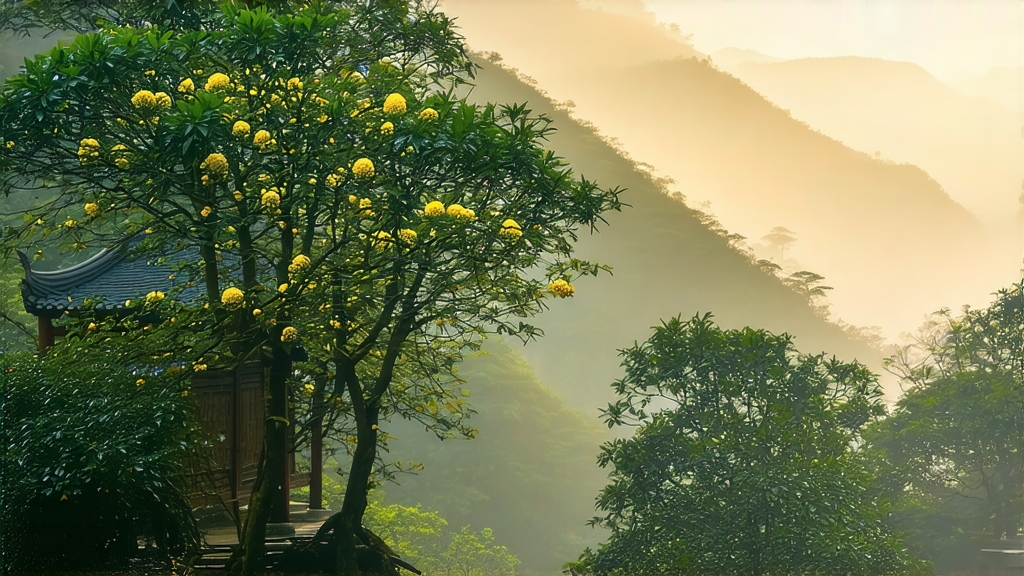
High on Meng Ding Mountain, where Sichuan’s clouds brush the shoulders of Tang-dynasty stone terraces, a tea once reserved for emperors still unfurls its velvet-yellow buds each early April. International drinkers may speak freely of Longjing or Pu-erh, yet few have tasted Meng Ding Huang Ya, the “Yellow Bud of Meng Ding,” a luminous strand in the slender necklace of China’s six great tea families. This essay invites the curious palate to travel 1,500 meters above sea level and 1,300 years back in time, tracing the leaf from imperial tribute to contemporary gaiwan, from bamboo baskets to biochemistry, from myth to mouth.
-
A leaf enters history
Legend places the first planting at the summit in 53 BCE, when Buddhist monk Gan Lu (“Sweet Dew”) carried tea seeds from India and planted them beneath the cliff still called Gan Lu Shi. By the Tang dynasty (618-907) the mountain’s fifteen monasteries were already forwarding spring buds to Chang’an courtiers who valued their “orchid-in-mist” aroma. The Song emperor Huizong (r. 1100-1126), himself a tea connoisseur and calligrapher, elevated Meng Ding Huang Ya to tribute status, requiring 360 kilograms annually wrapped in damask and escorted by armored caravan. When the Ming court shifted its taste to green teas, yellow production lapsed into folkloric memory; only in 1959 did Sichuan agronomists resurrect the technique, recovering palace records and aging farmers’ muscle memory. Today the tea remains a government-protected geographical indication, produced exclusively on the northern slope of the 1,452 m Gan Lu Peak within a 13-km² core zone. -
Varietal identity: one mountain, three micro-gardens
Purists recognize three contiguous gardens—Shangqing, Lingyuan, and Ganlu—each distinguished by microclimate and clone. Shangqing’s morning fog produces the most amino acids, yielding a broth reminiscent of sweet corn silk; Lingyuan’s afternoon sun stresses leaves into a brighter, mango-like note; Ganlu, shaded by wild magnolia, gives a quieter, lily finish. Yet all are picked as single buds or one bud with an unopened leaf, never larger, always before the Qingming festival when spring thunder first stirs the soil. The cultivar itself is a local sexually propagated seedling named “Meng Ding #9,” selected for its low catechin/high theanine ratio that softens astringency and primes the leaf for yellowing. -
Craft: the secret 48-hour sweat
After dawn plucking, buds ride downhill in bamboo crates lined with banana leaves to prevent compression. Withering lasts only 30 minutes under diffused mountain light—just enough to shed surface moisture. The critical step, “sealed yellowing” (men huang), begins when 4 kg of buds are piled 15 cm deep inside a cedar chamber at 28 °C and 75 % humidity. For two nights the tea master refuses sleep, turning the pile every 50 minutes to equalize respiration; oxidative enzymes convert chlorophyll into pheophytin while polyphenols oxidize just 5 %, tipping the leaf from green to pale canary. A final charcoal bake at 60 °C for eight minutes arrests enzymes, sets aroma, and reduces moisture to 5 %. The entire cycle—kill-green, rolling, pre-dry, yellowing, baking—must finish within 24 hours, a marathon that explains the tea’s rarity and price. -
Chemistry in the cup
Unlike green teas that lock in grassy volatiles, the yellowing step creates unique aroma compounds: 3-hexenyl benzoate (honey), linalool oxide (lychee), and the rare cis-jasmone (caramelized peach skin). Theaflavins remain low, but the 48-hour enzymatic dance doubles soluble sugars and triples γ-aminobutyric acid (GABA), delivering a natural umami calm that Chinese poets once likened to “drinking liquid moonlight.” Caffeine stays moderate at 2.8 %, lower than West Lake Dragon Well, making Meng Ding Huang Ya a favorite for scholars who wished to stay awake yet serene. -
Brewing: the 75-degree silence ritual
Western drinkers often scald delicate yellow buds with boiling water, extracting bitterness and disappointment. The mountain method is gentler: pre-w